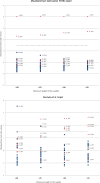Screening methods for detection of ancient Mycobacterium tuberculosis complex fingerprints in next-generation sequencing data derived from skeletal samples
- PMID: 31220249
- PMCID: PMC6586198
- DOI: 10.1093/gigascience/giz065
Screening methods for detection of ancient Mycobacterium tuberculosis complex fingerprints in next-generation sequencing data derived from skeletal samples
Abstract
Background: Recent advances in ancient DNA studies, especially in increasing isolated DNA yields and quality, have opened the possibility of analysis of ancient host microbiome. However, such pitfalls as spurious identification of pathogens based on fragmentary data or environmental contamination could lead to incorrect epidaemiological conclusions. Within the Mycobacterium genus, Mycobacterium tuberculosis complex members responsible for tuberculosis share up to ∼99% genomic sequence identity, while other more distantly related Mycobacteria other than M. tuberculosis can be causative agents for pulmonary diseases or soil dwellers. Therefore, reliable determination of species complex is crucial for interpretation of sequencing results.
Results: Here we present a novel bioinformatical approach, used for screening of ancient tuberculosis in sequencing data, derived from 28 individuals (dated 4400-4000 and 3100-2900 BC) from central Poland. We demonstrate that cost-effective next-generation screening sequencing data (∼20M reads per sample) could yield enough information to provide statistically supported identification of probable ancient disease cases.
Conclusions: Application of appropriate bioinformatic tools, including an unbiased selection of genomic alignment targets for species specificity, makes it possible to extract valid data from full-sample sequencing results (without subjective targeted enrichment procedures). This approach broadens the potential scope of palaeoepidaemiology both to older, suboptimally preserved samples and to pathogens with difficult intrageneric taxonomy.
Keywords: NGS; aTB; ancient DNA; ancient tuberculosis.
© The Author(s) 2019. Published by Oxford University Press.
Figures



Similar articles
-
Molecular analysis of skeletal tuberculosis in an ancient Egyptian population.J Med Microbiol. 2001 Apr;50(4):355-366. doi: 10.1099/0022-1317-50-4-355. J Med Microbiol. 2001. PMID: 11289521
-
Biomolecular identification of ancient Mycobacterium tuberculosis complex DNA in human remains from Britain and continental Europe.Am J Phys Anthropol. 2014 Feb;153(2):178-89. doi: 10.1002/ajpa.22417. Epub 2013 Nov 14. Am J Phys Anthropol. 2014. PMID: 24226751
-
Screening ancient tuberculosis with qPCR: challenges and opportunities.Philos Trans R Soc Lond B Biol Sci. 2015 Jan 19;370(1660):20130622. doi: 10.1098/rstb.2013.0622. Philos Trans R Soc Lond B Biol Sci. 2015. PMID: 25487341 Free PMC article.
-
Hit or miss - A metagenomic evaluation of intra-bone variability of host pathogen load in tuberculosis-infected human remains.Tuberculosis (Edinb). 2023 Dec;143S:102392. doi: 10.1016/j.tube.2023.102392. Epub 2023 Nov 25. Tuberculosis (Edinb). 2023. PMID: 38012935 Review.
-
Paleomicrobiology: Diagnosis and Evolution of Ancient Pathogens.Annu Rev Microbiol. 2019 Sep 8;73:639-666. doi: 10.1146/annurev-micro-090817-062436. Epub 2019 Jul 5. Annu Rev Microbiol. 2019. PMID: 31283430 Review.
Cited by
-
HAYSTAC: A Bayesian framework for robust and rapid species identification in high-throughput sequencing data.PLoS Comput Biol. 2022 Sep 30;18(9):e1010493. doi: 10.1371/journal.pcbi.1010493. eCollection 2022 Sep. PLoS Comput Biol. 2022. PMID: 36178955 Free PMC article.
-
Metagenomic next-generation sequencing of osteoarticular tissue for the diagnosis of suspected osteoarticular tuberculosis.Microbiol Spectr. 2024 Nov 8;12(12):e0359823. doi: 10.1128/spectrum.03598-23. Online ahead of print. Microbiol Spectr. 2024. PMID: 39513695 Free PMC article.
-
Bioarchaeological and palaeogenomic portrait of two Pompeians that died during the eruption of Vesuvius in 79 AD.Sci Rep. 2022 May 26;12(1):6468. doi: 10.1038/s41598-022-10899-1. Sci Rep. 2022. PMID: 35618734 Free PMC article.
-
Prognostic Significance of Tumor Mutation Burden among Patients with Non-small Cell Lung Cancer Who Received Platinum-based Adjuvant Chemotherapy: An Exploratory Study.J Cancer Prev. 2023 Dec 30;28(4):175-184. doi: 10.15430/JCP.2023.28.4.175. J Cancer Prev. 2023. PMID: 38205359 Free PMC article.
-
The Evolution of Diagnostic Techniques in the Paleopathology of Tuberculosis: A Scoping Review.Pathog Immun. 2023 Oct 18;8(1):93-116. doi: 10.20411/pai.v8i1.597. eCollection 2023. Pathog Immun. 2023. PMID: 37900966 Free PMC article.
References
-
- Barrett R, Kuzawa CW, McDade T, et al. .. Emerging and re-emerging infectious diseases: the third epidemiologic transition. Annu Rev Anthropol. 1998;27(1):247–71.
-
- Armelagos GJ, Cohen MN. Paleopathology at the Origins of Agriculture. Orlando, FL: Academic Press; 1984.
-
- Armelagos GJ, Goodman AH, Jacobs KH. The origins of agriculture: population growth during a period of declining health. Popul Environ. 1991;13(1):9–22.
-
- Ortner DJ, Putschar W. Identification of Pathological Conditions in Human Skeletal Remains. Smithsonian; 1985.
Publication types
MeSH terms
Substances
LinkOut - more resources
Full Text Sources

